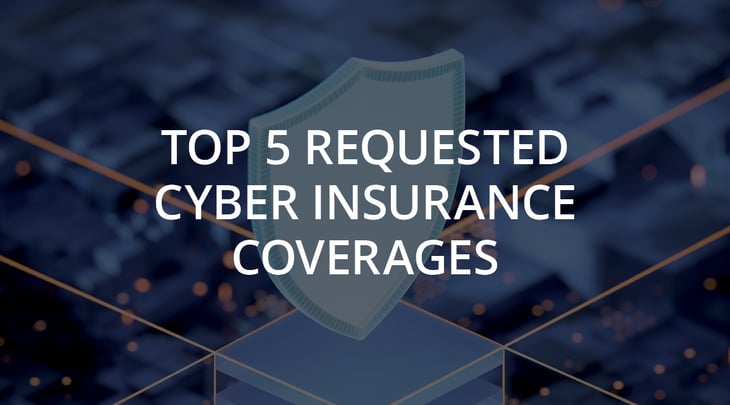Top 5 Requested Cyber Insurance Coverages
This is a guest post from Adam Hengst cyber insurance advisor at Camargo Insurance - an independent, award-winning agency specializing in cyber insurance nationwide.
Cyber-attacks are increasingly more sophisticated and costly. As a result, cyber insurance is becoming a requirement for many businesses and helps reduce the risk of business-critical damage when a cyber-attack occurs.
__________________________
The rise in remote work spurred by the pandemic has created a 67% increase in the frequency of cyber-attacks. The costs of cyber-attacks add up quickly between attorney fees, costs of forensics and third-party security tools, as well as notification costs. The pandemic has also accelerated the rate of digitalization; rarely-targeted sectors have become some of the most targeted industries. The rapid increase in demand for cybersecurity providers has opened more jobs than people to fill them. With this increase, there's been a rise in media coverage, causing an increase in the number and size of cyber insurance policies purchased.
Organizations across industries now face the reality of cyber-attacks being a matter of when - not if. With data in the Cloud, malicious actors are able to test stolen login information easier and quicker than before. Additionally, organizations are combating more sophisticated attacks, such as nation-state-type attacks. It is crucial for organizations to be prepared and have adequate cyber coverage. We are seeing many organizations and suppliers require cyber coverage to continue doing business.
Top 5 Cyber Insurance Coverages
-
Cyber Extortion/Ransomware covers the cost of the ransom request.
The most common type of cyber-attack in recent years has been ransomware. When on your computer, ransomware will encrypt the hard drive making it impossible to gain access without the key created by the hackers. To avoid having the information published, the hackers ask for a ransom to keep the files private and release them back to you.
-
Funds Transfer Fraud/Social Engineering covers the cost of loss of money and data if someone convinces an employee through phishing emails or phone calls to provide sensitive information to the attacker.
A typical example would be a hacker impersonating a client or vendor with a spoofed email address. The hacker, acting as your client or vendor, makes a common request such as a routine or expected payment but provides different account information.
-
Data Restoration covers the costs associated with restoring and replacing data after a breach.
When your business suffers a hack, critical data may be destroyed or encrypted by the hacker, leaving you stuck with spending the time and money to hire a team of cybersecurity experts to recover your data.
-
Cyber Business Interruption covers lost income during the period your business is down due to a cyber-attack and the additional costs to get up and running again quickly.
When your business suffers a hack, you may be shut down entirely or suffer a slowdown in sales while the hack is addressed. There is no coverage under your standard policy's business income coverage. Business income lost due to a cyber incident needs to come from a cyber policy.
-
Cyber-Related Dependent Business Interruption extends coverage to your losses resulting from a key vendor or technology partner suffering a cybersecurity breach.
Your CRM or ERP provider suffers a hack that results in your business losing revenue.
Finding the Right Coverage
Most businesses in the post-pandemic world will need cyber insurance. Industries that need to be especially careful of their cyber coverage are healthcare, manufacturing, financial services, and engineering, in that order. Manufacturing may come as a surprise, but the rise of automation in the sector, in short, has left the industry vulnerable to attack. If you have remote workers, you are at greater risk of attack than before.
The cyber landscape is constantly changing, and insurance companies are still scrambling to figure out how to ensure the risk. Prices are rising, and insurance companies are adding exclusions as claim volume and severity increase. Cyber policies will need to be reviewed more frequently to ensure no new exclusions affect your coverage. Rapid rate increases also create the possibility that your policy is no longer competitive in the current market.
It is best practice to look for a cyber insurance provider that not only provides the right coverage but provides employee training and a cybersecurity check-up. Preventative measures are as necessary as the actual coverage. The best way to handle a cyber-attack is to prevent it from happening. Many policies include free training and security checks. If your current insurance agent hasn't provided you with a clear summary of coverages, identified potential gaps, and helped you implement preventative measures, it would be wise to reach out for a 2nd opinion.
Free Expert Resources
Camargo Insurance has a quoting platform that allows for near-instant cyber quotes. With just business name, address, revenue, and website, it’s capable of scanning for potential vulnerabilities in your cyber defense, which allows the insurance company to determine eligibility and rates quickly. A comparison of coverage and rates comes with the quotes; your policy is provided along with a brief description of coverages. You get quotes from top-rated cyber insurance companies without the hassle of filling out pages of applications and an expert to follow up. If you would like to move forward, an agent will then check for accuracy, answer any questions, and implement the policy.
Interlink Cloud Advisors has also recently published a Cybersecurity Insurance webinar and the requirements they are seeing. The webinar also discusses options to utilize Microsoft technologies, which you may already own, to meet those requirements and help keep your organization safe through reduced risk. View the on-demand webinar here.


